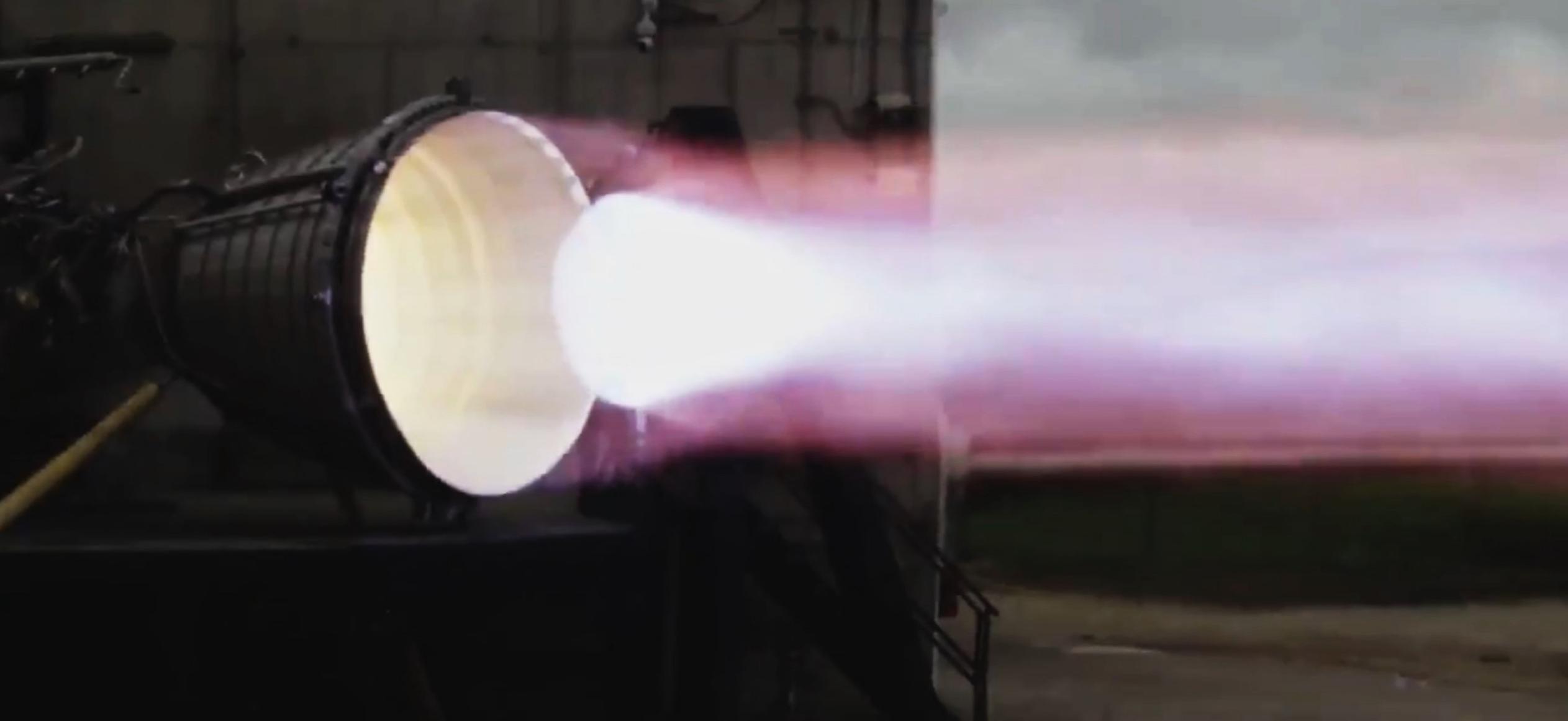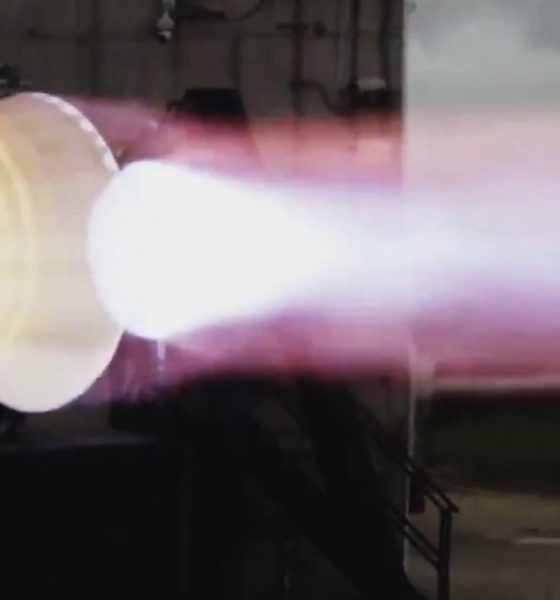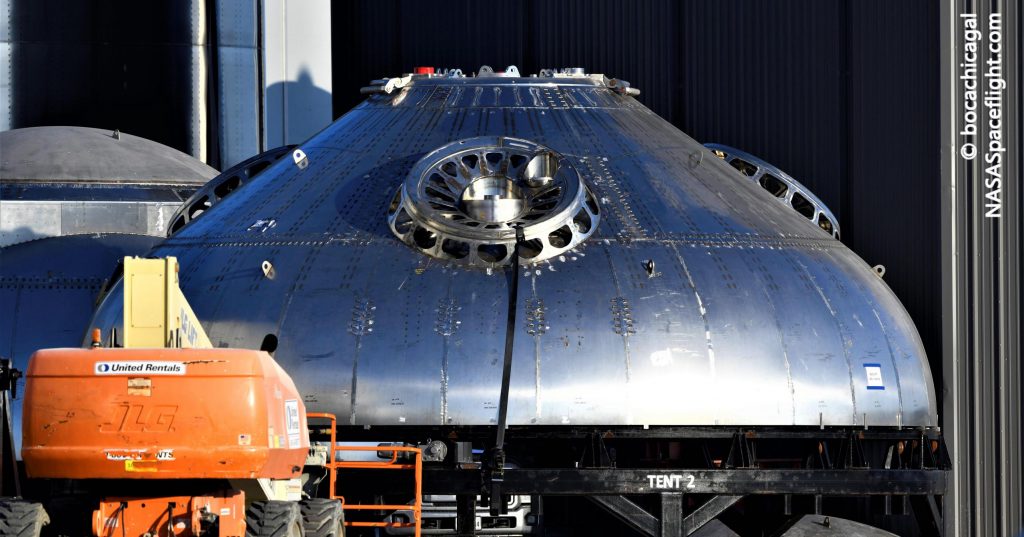

News
SpaceX sends Starship’s first vacuum Raptor engine to Boca Chica
For the first time, SpaceX has shipped a vacuum-optimized Raptor engine to its Boca Chica, Texas Starship factory days after the company’s present reiterated plans for an inaugural orbital launch attempt as early as July.
Back in March 2021, CEO Elon Musk confirmed that he’d set SpaceX a goal of attempting Starship’s first orbital launch no later than the end of July – around four and a half months distant at the time. Fifteen weeks later, though the prospects of an orbital launch attempt happening in July have practically shrunk to zero, SpaceX COO and President Gwynne Shotwell – best known for acting as a more grounded foil to Musk’s often impractical schedule estimates – reiterated that the company is still “shooting for July” for Starship’s first orbital launch attempt.
As of late June, hitting that target would require SpaceX to string together numerous extraordinary feats of engineering and rocketry in record time or attempt some extremely unorthodox corner-cutting.
The launch pad and launch vehicle hardware needed for Starship’s first space shot are currently far from ready for flight. On June 24th, Musk unexpectedly revealed that the Super Heavy booster prototype SpaceX is now in the late stages of assembly isn’t actually the booster that will carry Starship on its first space launch attempt. In other words, though dozens of rings in various states of work are strewn about SpaceX’s Boca Chica factory, the company has yet to begin assembling the massive 65m (~215 ft) tall booster required for the first orbital launch attempt.
Using Super Heavy Booster 3 (B3) as a ruler, assembly could easily take 9-10 weeks – starting whenever the process actually begins. If SpaceX started stacking Booster 4 today, in other words, it’s unlikely that the rocket would even be complete by the end of August. Barring SpaceX taking unprecedented shortcuts, completing the booster is just part of the process of preparing for flight and B4 would still need to be qualified for flight, likely involving at least one cryogenic proof and static fire test.
In a best-case scenario where SpaceX begins assembly today, manages to halve Booster 4 assembly time in one fell swoop, the sneaks the second Super Heavy ever completed through qualification testing in a single week, the orbital flight test booster still wouldn’t be ready for Starship installation (likely another unprecedented first) before mid-August.
That would then leave SpaceX five or six weeks to fully assemble Starship S20, a process that has yet to begin. Like Starship SN15, which Musk said sported “hundreds of improvements”, Musk has also stated that Ship 20 and all after it will feature another batch of upgrades needed to take Starship orbital. Starship SN15 was very gradually stacked and assembled over the course of almost four months, though that slow assembly can likely be blamed on the fact that SpaceX is busy testing Starships SN8 through SN11 and was effectively waiting to see if any other major changes might be required.

While most of S20’s upgrades are a mystery, the ship’s thrust dome – spotted in work at Boca Chica earlier this month – has already confirmed that the prototype will be the first with the necessary hardware for Raptor Vacuum engine installation. That likely means that S20 will also be the first Starship to attempt to static fire six Raptor engines*, potentially producing more thrust than a Falcon 9 booster. On June 27th, one such vacuum-optimized Raptor (RVac) arrived in Boca Chica for the first time ever, making it clear that the comparatively brand new engine may already be ready to start integrated Starship testing.
*Update: SpaceX CEO Elon Musk says that the Raptor Vacuum delivered to Boca Chica on June 27th is, in fact, meant for Starship S20, seemingly confirming that the prototype will fly with a full six Raptor engines.
Of course, beyond Starship and Super Heavy, SpaceX also has a great deal of work left to get the rocket’s first orbital-class launch facilities partially operational. SpaceX will need to complete and activate at least one or two more custom-built propellant storage tanks, sleeve those three or four tanks with three or four massive thermos-like ‘shells,’ complete thousands of feet of insulated plumbing and wiring, finish a massive ‘launch table,’ install that table on a six-legged ‘launch mount;’ outfit that table and mount with an array of power, avionics, hydraulics, and fueling equipment and plumbing; complete a ~145m (~475 ft) ‘integration tower,’ and perform the first fit checks and shakedown tests with a real booster or Starship.
Only then will SpaceX be able to attempt Starship’s first space launch. All told, it might not be literally impossible for SpaceX to complete all the above work in less than five weeks, but it’s safe to say that the odds of that happening could probably make a lottery ticket blush. Regardless, if Starship reaches orbit at any point before the end of 2021, it would beat out simpler “next-generation” rockets like Ariane 6, ULA’s Vulcan, and Blue Origin’s New Glenn despite beginning concerted development years later and with a far less certain funding situation.

News
Tesla (TSLA) receives “Buy” rating and $551 PT from Canaccord Genuity
He also maintained a “Buy” rating for TSLA stock over the company’s improving long-term outlook, which is driven by autonomy and robotics.

Canaccord Genuity analyst George Gianarikas raised his Tesla (NASDAQ:TSLA) price target from $482 to $551. He also maintained a “Buy” rating for TSLA stock over the company’s improving long-term outlook, which is driven by autonomy and robotics.
The analyst’s updated note
Gianarikas lowered his 4Q25 delivery estimates but pointed to several positive factors in the Tesla story. He noted that EV adoption in emerging markets is gaining pace, and progress in FSD and the Robotaxi rollout in 2026 represent major upside drivers. Further progress in the Optimus program next year could also add more momentum for the electric vehicle maker.
“Overall, yes, 4Q25 delivery expectations are being revised lower. However, the reset in the US EV market is laying the groundwork for a more durable and attractive long-term demand environment.
“At the same time, EV penetration in emerging markets is accelerating, reinforcing Tesla’s potential multi‑year growth runway beyond the US. Global progress in FSD and the anticipated rollout of a larger robotaxi fleet in 2026 are increasingly important components of the Tesla equity story and could provide sentiment tailwinds,” the analyst wrote.
Tesla’s busy 2026
The upcoming year would be a busy one for Tesla, considering the company’s plans and targets. The autonomous two-seat Cybercab has been confirmed to start production sometime in Q2 2026, as per Elon Musk during the 2025 Annual Shareholder Meeting.
Apart from this, Tesla is also expected to unveil the next-generation Roadster on April 1, 2026. Tesla is also expected to start high-volume production of the Tesla Semi in Nevada next year.
Apart from vehicle launches, Tesla has expressed its intentions to significantly ramp the rollout of FSD to several regions worldwide, such as Europe. Plans are also underway to launch more Robotaxi networks in several more key areas across the United States.
News
Waymo sues Santa Monica over order to halt overnight charging sessions
In its complaint, Waymo argued that its self-driving cars’ operations do not constitute a public nuisance, and compliance with the city’s order would cause the company irreparable harm.

Waymo has filed a lawsuit against the City of Santa Monica in Los Angeles County Superior Court, seeking to block an order that requires the company to cease overnight charging at two facilities.
In its complaint, Waymo argued that its self-driving cars’ operations do not constitute a public nuisance, and compliance with the city’s order would cause the company irreparable harm.
Nuisance claims
As noted in a report from the Los Angeles Times, Waymo’s two charging sites at Euclid Street and Broadway have operated for about a year, supporting the company’s growing fleet with round-the-clock activity. Unfortunately, this has also resulted in residents in the area reportedly being unable to sleep due to incessant beeping from self-driving taxis that are moving in and out of the charging stations around the clock.
Frustrated residents have protested against the Waymos by blocking the vehicles’ paths, placing cones, and “stacking” cars to create backups. This has also resulted in multiple calls to the police.
Last month, the city issued an order to Waymo and its charging partner, Voltera, to cease overnight operations at the charging locations, stating that the self-driving vehicles’ activities at night were a public nuisance. A December 15 meeting yielded no agreement on mitigations like software rerouting. Waymo proposed changes, but the city reportedly insisted that nothing would satisfy the irate residents.
“We are disappointed that the City has chosen an adversarial path over a collaborative one. The City’s position has been to insist that no actions taken or proposed by Waymo would satisfy the complaining neighbors and therefore must be deemed insufficient,” a Waymo spokesperson stated.
Waymo pushes back
In its legal complaint, Waymo stated that its “activities at the Broadway Facilities do not constitute a public nuisance.” The company also noted that it “faces imminent and irreparable harm to its operations, employees, and customers” from the city’s order. The suit also stated that the city was fully aware that the Voltera charging sites would be operating around the clock to support Waymo’s self-driving taxis.
The company highlighted over one million trips in Santa Monica since launch, with more than 50,000 rides starting or ending there in November alone. Waymo also criticized the city for adopting a contentious strategy against businesses.
“The City of Santa Monica’s recent actions are inconsistent with its stated goal of attracting investment. At a time when the City faces a serious fiscal crisis, officials are choosing to obstruct properly permitted investment rather than fostering a ‘ready for business’ environment,” Waymo stated.
News
Tesla FSD v14.2.2 is getting rave reviews from drivers
So far, early testers have reported buttery-smooth drives with confident performance, even at night or on twisty roads.

Tesla Full Self-Driving (Supervised) v14.2.2 is receiving positive reviews from owners, with several drivers praising the build’s lack of hesitation during lane changes and its smoother decision-making, among others.
The update, which started rolling out on Monday, also adds features like dynamic arrival pin adjustment. So far, early testers have reported buttery-smooth drives with confident performance, even at night or on twisty roads.
Owners highlight major improvements
Longtime Tesla owner and FSD user @BLKMDL3 shared a detailed 10-hour impression of FSD v14.2.2, noting that the system exhibited “zero lane change hesitation” and “extremely refined” lane choices. He praised Mad Max mode’s performance, stellar parking in locations including ticket dispensers, and impressive canyon runs even in dark conditions.
Fellow FSD user Dan Burkland reported an hour of FSD v14.2.2’s nighttime driving with “zero hesitations” and “buttery smooth” confidence reminiscent of Robotaxi rides in areas such as Austin, Texas. Veteran FSD user Whole Mars Catalog also demonstrated voice navigation via Grok, while Tesla owner Devin Olsen completed a nearly two-hour drive with FSD v14.2.2 in heavy traffic and rain with strong performance.
Closer to unsupervised
FSD has been receiving rave reviews, even from Tesla’s competitors. Xpeng CEO He Xiaopeng, for one, offered fresh praise for FSD v14.2 after visiting Silicon Valley. Following extended test drives of Tesla vehicles running the latest FSD software, He stated that the system has made major strides, reinforcing his view that Tesla’s approach to autonomy is indeed the proper path towards autonomy.
According to He, Tesla’s FSD has evolved from a smooth Level 2 advanced driver assistance system into what he described as a “near-Level 4” experience in terms of capabilities. While acknowledging that areas of improvement are still present, the Xpeng CEO stated that FSD’s current iteration significantly surpasses last year’s capabilities. He also reiterated his belief that Tesla’s strategy of using the same autonomous software and hardware architecture across private vehicles and robotaxis is the right long-term approach, as it would allow users to bypass intermediate autonomy stages and move closer to Level 4 functionality.








